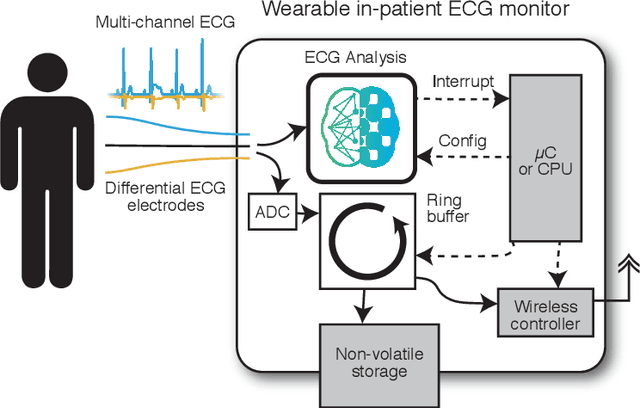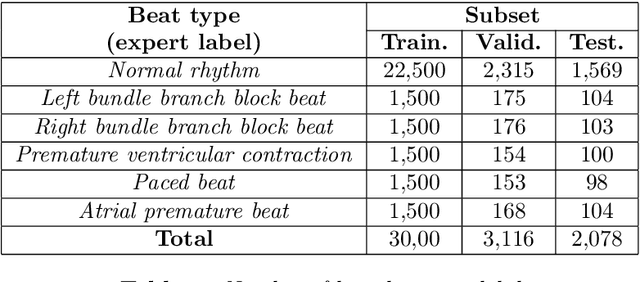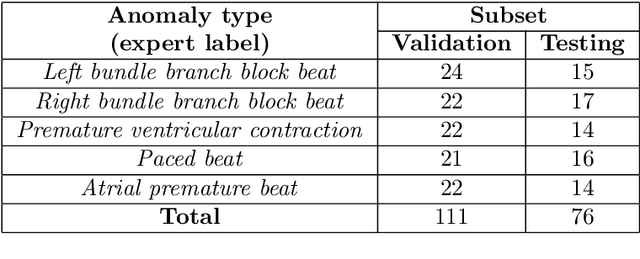Dylan Richard Muir
Real-time Sub-milliwatt Epilepsy Detection Implemented on a Spiking Neural Network Edge Inference Processor
Oct 22, 2024Abstract:Analyzing electroencephalogram (EEG) signals to detect the epileptic seizure status of a subject presents a challenge to existing technologies aimed at providing timely and efficient diagnosis. In this study, we aimed to detect interictal and ictal periods of epileptic seizures using a spiking neural network (SNN). Our proposed approach provides an online and real-time preliminary diagnosis of epileptic seizures and helps to detect possible pathological conditions.To validate our approach, we conducted experiments using multiple datasets. We utilized a trained SNN to identify the presence of epileptic seizures and compared our results with those of related studies. The SNN model was deployed on Xylo, a digital SNN neuromorphic processor designed to process temporal signals. Xylo efficiently simulates spiking leaky integrate-and-fire neurons with exponential input synapses. Xylo has much lower energy requirments than traditional approaches to signal processing, making it an ideal platform for developing low-power seizure detection systems.Our proposed method has a high test accuracy of 93.3% and 92.9% when classifying ictal and interictal periods. At the same time, the application has an average power consumption of 87.4 uW(IO power) + 287.9 uW(computational power) when deployed to Xylo. Our method demonstrates excellent low-latency performance when tested on multiple datasets. Our work provides a new solution for seizure detection, and it is expected to be widely used in portable and wearable devices in the future.
Real-time ultra-low power ECG anomaly detection using an event-driven neuromorphic processor
Nov 13, 2019



Abstract:Accurate detection of pathological conditions in human subjects can be achieved through off-line analysis of recorded biological signals such as electrocardiograms (ECGs). However, human diagnosis is time-consuming and expensive, as it requires the time of medical professionals. This is especially inefficient when indicative patterns in the biological signals are infrequent. Moreover, patients with suspected pathologies are often monitored for extended periods, requiring the storage and examination of large amounts of non-pathological data, and entailing a difficult visual search task for diagnosing professionals. In this work we propose a compact and sub-mW low power neural processing system that can be used to perform on-line and real-time preliminary diagnosis of pathological conditions, to raise warnings for the existence of possible pathological conditions, or to trigger an off-line data recording system for further analysis by a medical professional. We apply the system to real-time classification of ECG data for distinguishing between healthy heartbeats and pathological rhythms. Multi-channel analog ECG traces are encoded as asynchronous streams of binary events and processed using a spiking recurrent neural network operated in a reservoir computing paradigm. An event-driven neuron output layer is then trained to recognize one of several pathologies. Finally, the filtered activity of this output layer is used to generate a binary trigger signal indicating the presence or absence of a pathological pattern. We validate the approach proposed using a Dynamic Neuromorphic Asynchronous Processor (DYNAP) chip, implemented using a standard 180 nm CMOS VLSI process, and present experimental results measured from the chip.
Feed-forward approximations to dynamic recurrent network architectures
Sep 15, 2017Abstract:Recurrent neural network architectures can have useful computational properties, with complex temporal dynamics and input-sensitive attractor states. However, evaluation of recurrent dynamic architectures requires solution of systems of differential equations, and the number of evaluations required to determine their response to a given input can vary with the input, or can be indeterminate altogether in the case of oscillations or instability. In feed-forward networks, by contrast, only a single pass through the network is needed to determine the response to a given input. Modern machine-learning systems are designed to operate efficiently on feed-forward architectures. We hypothesised that two-layer feedforward architectures with simple, deterministic dynamics could approximate the responses of single-layer recurrent network architectures. By identifying the fixed-point responses of a given recurrent network, we trained two-layer networks to directly approximate the fixed-point response to a given input. These feed-forward networks then embodied useful computations, including competitive interactions, information transformations and noise rejection. Our approach was able to find useful approximations to recurrent networks, which can then be evaluated in linear and deterministic time complexity.
 Add to Chrome
Add to Chrome Add to Firefox
Add to Firefox Add to Edge
Add to Edge